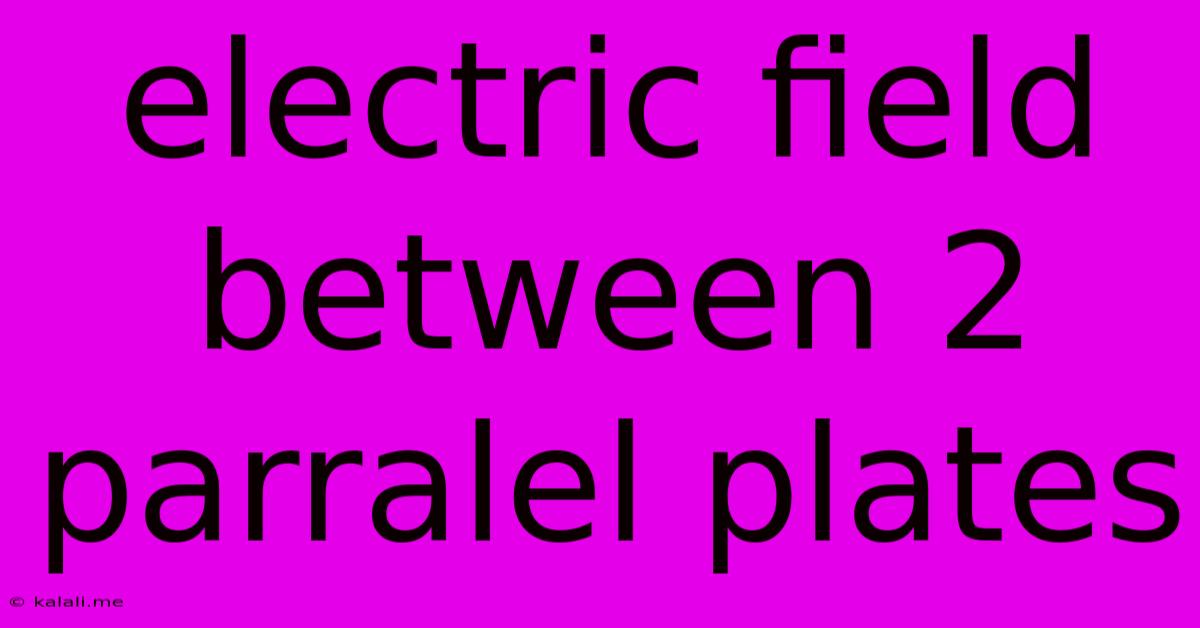Electric Field Between 2 Parralel Plates
Kalali
May 31, 2025 · 3 min read

Table of Contents
Understanding the Electric Field Between Two Parallel Plates
The electric field between two parallel plates is a fundamental concept in electrostatics with numerous applications in various fields, from capacitors to particle accelerators. This article will delve into the characteristics of this field, exploring its uniformity, calculations, and practical implications. Understanding this concept is crucial for anyone studying electricity and magnetism.
What is an Electric Field?
Before diving into parallel plates, let's briefly review electric fields. An electric field is a region of space where a charged particle experiences a force. This force is proportional to the charge of the particle and the strength of the electric field at that point. Electric fields are represented by electric field lines, which indicate the direction of the force on a positive test charge.
The Electric Field Between Parallel Plates: A Uniform Field
When two parallel plates are charged with equal and opposite charges (+Q and -Q), a uniform electric field is established between them. Uniformity means the electric field strength (E) is constant across the entire region between the plates, disregarding edge effects. This is a significant characteristic that simplifies many calculations and applications.
This uniformity arises because the electric field lines emanating from the positive plate are largely attracted towards the negative plate, creating a nearly constant field density between them. The closer the plates are, the more uniform this field becomes.
Calculating the Electric Field Strength (E)
The electric field strength (E) between two parallel plates can be calculated using the following formula:
E = V/d
Where:
- E is the electric field strength (measured in Volts per meter, V/m)
- V is the potential difference between the plates (measured in Volts, V)
- d is the distance between the plates (measured in meters, m)
This formula assumes a perfect vacuum between the plates and ignores edge effects. In reality, the field strength might be slightly weaker near the edges of the plates.
Factors Affecting the Electric Field Strength:
Several factors influence the strength of the electric field between parallel plates:
- Potential Difference (V): A higher potential difference leads to a stronger electric field.
- Distance between Plates (d): A smaller distance between plates results in a stronger electric field.
- Charge Density (σ): The surface charge density (charge per unit area) on the plates directly impacts the field strength. A higher charge density means a stronger field. This relationship can be expressed as: E = σ/ε₀, where ε₀ is the permittivity of free space.
- Dielectric Material: Introducing a dielectric material between the plates reduces the electric field strength. The reduction factor depends on the dielectric constant of the material.
Applications of Parallel Plate Capacitors:
The concept of a uniform electric field between parallel plates is central to the operation of capacitors. Capacitors are electronic components used to store electrical energy. Their ability to store charge is directly related to the area of the plates, the distance between them, and the dielectric constant of the material between them. Parallel plate capacitors are widely used in various electronic circuits, ranging from simple filters to complex integrated circuits.
Other applications include:
- Particle Accelerators: Uniform electric fields are used to accelerate charged particles in linear accelerators.
- Electrostatic Deflection: In devices like cathode ray tubes (CRTs), uniform electric fields are used to deflect beams of electrons.
- Electric Field Experiments: The uniform field facilitates precise experimentation in electrostatics, simplifying calculations and allowing for more controlled measurements.
Conclusion:
The electric field between two parallel plates is a crucial concept in electrostatics with significant practical applications. The uniformity of the field, its easy calculability, and its role in devices such as capacitors make it a foundational topic for understanding the behavior of electric fields and their use in various technologies. Understanding the factors influencing the field strength allows for precise control and design of electric field-based devices and experiments.
Latest Posts
Latest Posts
-
What Happens When You Overfill Transmission
Jun 02, 2025
-
How To Fix Water Damaged Swollen Wood Floor
Jun 02, 2025
-
Is Red Pepper And Cayenne Pepper The Same
Jun 02, 2025
-
Synonyms For Stuck In The Past
Jun 02, 2025
-
Blender Gradient Tool Front Faces Only
Jun 02, 2025
Related Post
Thank you for visiting our website which covers about Electric Field Between 2 Parralel Plates . We hope the information provided has been useful to you. Feel free to contact us if you have any questions or need further assistance. See you next time and don't miss to bookmark.